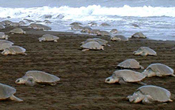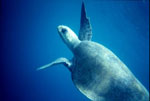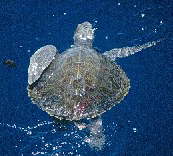Olive Ridley Turtle (Lepidochelys olivacea)
Status | Taxonomy | Species Description | Habitat | Distribution |
Population Trends | Threats | Conservation Efforts | Regulatory Overview |
Key Documents | More Info
Status
ESA Endangered - breeding populations on the Pacific Coast of Mexico
ESA Threatened - all other populations
Taxonomy
Kingdom: Animalia
Phylum: Chordata
Class: Reptilia
Order: Testudines
Family: Cheloniidae
Genus: Lepidochelys
Species: olivacea
Species Description
The olive ridley is considered the most abundant sea turtle in the world, with an estimated 800,000 nesting females annually. The olive ridley gets its name from the grayish green coloration of its heart-shaped carapace (top shell).
Adult turtles are relatively small, weighing on average around 100 lbs (45 kg). The size and morphology of the olive ridley varies from region to region. Nesting females vary in size between 22 and 31 inches (56-79 cm), with the largest animals being observed on the Pacific coast of Mexico. There are often only five pairs of costal "scutes" on the carapace, but that number varies. Some individuals have been documented having as many as nine pairs of costal scutes. Each of the four flippers has one or two visible claws. The carapace of eastern Pacific olive ridleys is greater in height than other populations. Western Atlantic olive ridleys usually have a darker coloration than eastern Pacific olive ridleys.
The olive ridley has one of the most extraordinary nesting habits in the natural world. Large groups of turtles gather off shore of nesting beaches. Then, all at once, vast numbers of turtles come ashore and nest in what is known as an "arribada". During these arribadas, hundreds to thousands of females come ashore to lay their eggs. At many nesting beaches, the nesting density is so high that previously laid egg clutches are dug up by other females excavating the nest to lay their own eggs.
There are many theories on what triggers an arribada, including offshore winds, lunar cycles, and the release of pheromones by females. Despite these theories, scientists have yet to determine the actual cues for ridley arribadas. Not all females nest during an arribada, instead some are solitary nesters. Some olive ridleys employ a mixed nesting strategy. For example, a single female might nest during an arribada, as well as nest alone during the same nesting season. Arribada nesting is a behavior found only in the genus Lepidochelys. Although other turtles have been documented nesting in groups, no other turtles (marine or otherwise) have been observed nesting in such mass numbers and synchrony.
Olive ridleys reach sexual maturity around 15 years, a young age compared to some other sea turtle species. Females nest every year, once or twice a season, laying clutches of approximately 100 eggs. Incubation takes 50-60 days. After incubation, hatchlings emerge weighing less than an ounce (< 28 g) and measuring about 1.5 inches (3.8 cm). The hatchlings are mostly black with a greenish hue on the sides.
Habitat
The olive ridley is mainly a "pelagic" sea turtle, but has been known to inhabit coastal areas, including bays and estuaries. Olive ridleys mostly breed annually and have an annual migration from pelagic foraging, to coastal breeding and nesting grounds, back to pelagic foraging. Trans-Pacific ships have observed olive ridleys over 2,400 miles (4,000 km) from shore.
The olive ridley is omnivorous, meaning it feeds on a wide variety of food items, including algae, lobster, crabs, tunicates, mollusks, shrimp, and fish. Olive ridleys dive to depths of about 500 feet (150 m), to forage on "benthic" invertebrates.
Distribution
Olive ridleys are globally distributed in the tropical regions of the South Atlantic, Pacific, and Indian Oceans. In the South Atlantic Ocean, they are found along the Atlantic coasts of West Africa and South America. In the Eastern Pacific, they occur from Southern California to Northern Chile.
Olive ridleys often migrate great distances between feeding and breeding grounds. In two separate satellite telemetry studies, both male and female olive ridleys leaving the breeding and nesting grounds off the Pacific coast of Costa Rica migrated out to the deep waters of the Pacific Ocean. Both sexes migrated to waters deeper than 9800 ft (3000 m). The results did not indicate a directed migration to a specific foraging area, instead it appears the olive ridley forages opportunistically in deep ocean waters (Plotkin et al. 1994).
Arribadas occur on a few beaches worldwide in the eastern Pacific and northern Indian oceans. In the eastern Pacific, arribadas occur from June through December on certain beaches on the coasts of Mexico, Nicaragua, and Costa Rica and on a single beach in Panama. In the northern Indian Ocean, arribadas occur on three different beaches along the coast of India. Solitary nesting occurs extensively throughout this species' range; nesting has been documented in approximately 40 countries worldwide.
|
Population Trends
The olive ridley is listed as endangered by the IUCN ![]() . Degradation of nesting beaches, ongoing directed harvest, and bycatch in fisheries have all contributed to the decline of the species. The olive ridley may be the most abundant sea turtle on the planet, but some argue that it is also the most exploited.
. Degradation of nesting beaches, ongoing directed harvest, and bycatch in fisheries have all contributed to the decline of the species. The olive ridley may be the most abundant sea turtle on the planet, but some argue that it is also the most exploited.
According to the Marine Turtle Specialist Group (MTSG) of the IUCN, there has been a 50% reduction in population size since the 1960s. Although some nesting populations have increased in the past few years, the overall reduction is greater than the overall increase.
Since 1967, there has been an 80% reduction in certain nesting populations in the western Atlantic Ocean (Surinam, French Guiana, and Guyana) (USFWS 2005). In the Eastern Atlantic Ocean, lack of data and trends on specific nesting beaches make it difficult to estimate nesting populations. Along the entire west coast of Africa, nesting females and eggs are regularly taken for consumption, except where research stations have been established. This impact is likely extremely devastating to the entire Eastern Atlantic population (Plotkin ed. 2007).
Prior to 1950, an estimated ten million olive ridleys nested on the Pacific coast of Mexico. In the mid-1960s, an olive ridley fishery developed in Mexico and Ecuador, and the taking of eggs and females also increased, which devasted the population. Over 20 nesting populations have been severely depleted since the 1960s and only a single arribada nesting beach remains in La Escobilla, Mexico. The other nesting populations from 40 years ago have yet to recover despite increased protection. Further, in Guatemala, solitary nesting turtles have decreased 34% between 1981 and 1997 (Muccio 1999).
Gahirmatha, Orissa, India used to be one of the largest arribada nesting sites in the world. Over the past five years at Gahirmatha, there has been an arribada nesting event in only two of those five years. Additionally, between 1996 and 2002, the average size of nesting females declined at that site, indicative of a declining population (Plotkin ed. 2007). Declines in solitary nesting of olive ridleys have been recorded in Bangladesh, Myanmar, Malaysia, and Pakistan. In particular, the number of nests in Terengganu, Malaysia has declined from thousands of nests to just a few dozen per year (Limpus 1995).
Not all populations are depleted. Some nesting populations are currently stable and/or increasing. In Sergipe, Brazil, strict nest protection has led to increases of the nesting population over the past 20 years. In La Escobilla, Mexico, conservation measures, such as increased nesting beach protection and closure of the turtle fishery in 1990, have led to a dramatic increase in the once largest nesting population in the world. The number of olive ridley nests has increased from 50,000 in 1988 to over 700,000 in 1994 to more than a million nests in 2000 (Márquez et al. 2002). This dramatic improvement gives hope that with strict protections the once depleted populations can begin recovering.
Threats
The principal cause of the historical, worldwide decline of the olive ridley sea turtle is long-term collection of eggs and killing of adults on nesting beaches. Because arribadas concentrate females and nests in time and space, they allow for mass killing of adult females as well as the taking of an extraordinary number of eggs. These threats continue in some areas of the world today, compromising efforts to recover this species.
In the western south Atlantic Ocean, killing adults and collecting eggs of all nesting sea turtle species is historically widespread in the Guianas and northeastern Brazil. Despite a current prohibition on olive ridley egg harvest in Suriname, an estimated 40% of the olive ridley nests were harvested in 1995 (Hoekert et al. 1996). In the eastern North Atlantic Ocean, nesting olive ridleys are captured along the entire west coast of Africa and sold in local and regional markets. A survey of 27 west African nations indicated that nesting females were killed in 14 of those countries.
In the eastern Pacific Ocean, killing sea turtles and collecting their eggs has occurred for hundreds of years. Little data on historical egg taking in Mexico currently exist, but egg collection has previously reached nearly 100% at solitary nesting sites. In many places, egg collecting currently continues at this level (Plotkin ed. 2007).
Throughout the Indian Ocean, nesting populations of olive ridleys have declined due to both killing of nesting females at solitary nesting beaches and a directed fishery for the species concentrated at the major arribada nesting beach in Orissa, India during the 1970s.
Expansion of the shrimp trawling fishery in the eastern Indian Ocean in the mid-1970s has resulted in numerous olive ridley deaths. During the 1982-1983 nesting season, over 7,000 carcasses washed ashore over a 9 mile (15 km) stretch of beach. Between 1993 and 1999, more than 46,200 carcasses were recorded by beach surveyors, with a peak during the 1997-1998 seasons of 13,575 dead olive ridleys. Over 10,000 olive ridley carcasses a year have been counted on the Orissa coast since 1999 (Wright and Mohanty 2006). These carcasses have largely been attributed to the shrimp trawl fishery, but trawling is not the only source of olive ridley mortality in the Eastern Indian Ocean. On February 17, 2002, 205 dead olive ridleys entangled in a section of gillnet were washed ashore at Gundalba Beach, Orissa (Wright and Mohanty 2002).
Additionally, incidental captures in fishing gear, primarily in longlines, but also in trawls, gill nets, purse seines, and hook and line, is a serious ongoing source of mortality that adversely affects the species' recovery. Specifically, incidental capture of sea turtles in shrimp trawls along the coast of Central America is estimated as exceeding 60,000 sea turtles annually, most of which are olive ridleys (Arauz 1996).
For more information, please visit our threats to marine turtles page.
|
Conservation Efforts
The highly migratory behavior of olive ridleys makes them shared resources among many nations. Therefore, conservation efforts for olive ridley populations in one country may be jeopardized by activities in another. Protecting olive ridley sea turtles in U.S. waters alone is important but not sufficient to ensure the continued existence of the species.
Olive ridley turtles are protected by various international treaties and agreements as well as national laws. They are listed in Appendix I of the Convention on International Trade in Endangered Species of Wild Flora and Fauna (CITES), which means that international trade of this species is prohibited. Olive ridleys are listed in Appendices I and II of the Convention on Migratory Species (CMS ![]() ) and are protected under the following auspices of CMS: the Memorandum of Understanding on the Conservation and Management of Marine Turtles and their Habitats of the Indian Ocean and South-East Asia (IOSEA) and the Memorandum of Understanding Concerning Conservation Measures for Marine Turtles of the Atlantic Coast of Africa
) and are protected under the following auspices of CMS: the Memorandum of Understanding on the Conservation and Management of Marine Turtles and their Habitats of the Indian Ocean and South-East Asia (IOSEA) and the Memorandum of Understanding Concerning Conservation Measures for Marine Turtles of the Atlantic Coast of Africa ![]() [pdf]. Olive ridleys are also protected under Annex II of the Specially Protected Areas and Wildlife (SPAW
[pdf]. Olive ridleys are also protected under Annex II of the Specially Protected Areas and Wildlife (SPAW ![]() ) Protocol of the Cartagena Convention. Additionally, the U.S. is a party to the Inter-American Convention for the Protection and Conservation of Sea Turtles (IAC
) Protocol of the Cartagena Convention. Additionally, the U.S. is a party to the Inter-American Convention for the Protection and Conservation of Sea Turtles (IAC ![]() ), which is the only binding international treaty dedicated exclusively to sea turtles, including olive ridleys.
), which is the only binding international treaty dedicated exclusively to sea turtles, including olive ridleys.
NMFS has worked closely with the shrimp trawl fishing industry to develop turtle excluder devices (TEDs) to reduce the mortality of sea turtles incidentally captured in shrimp trawl gear. TEDs that are large enough to exclude even the largest sea turtles are now required in shrimp trawl nets. Since 1989, the U.S. has embargoed shrimp harvested in a manner that adversely affects sea turtles. The import ban does not apply to nations that have adopted sea turtle protection programs comparable to that of the United States (e.g., require and enforce the use of TEDs) or to nations where incidental capture in shrimp fisheries does not present a threat to sea turtles (e.g., nations that fish for shrimp in areas where sea turtles do not occur). The U.S. Department of State (DOS) is the principal implementing agency of this law, while NMFS serves as technical advisor. NMFS has provided extensive TED training throughout the world.
Regulatory Overview
The olive ridley turtle was listed under the ESA on July 28, 1978. The breeding populations in the Pacific coast of Mexico are listed as endangered; elsewhere the species is listed as threatened.
NMFS implements measures to reduce sea turtle interactions in fisheries by regulations and permits under the ESA and Magnuson-Stevens Fishery Conservation and Management Act. Since the early 1990s, NMFS has implemented sea turtle conservation measures including, but not limited to, TEDs in trawl fisheries, large circle hooks in longline fisheries, time and area closures for gillnets, and modifications to pound net leaders. For more information, please visit our NMFS regulations to protect marine turtles page.
Key Documents
(All documents are in PDF format.)
| Title | Federal Register | Date |
|---|---|---|
| 5-Year Review | n/a | 08/31/2007 |
| Recovery Plan - U.S. Pacific | 63 FR 28359 | 05/22/1998 |
| Status Review of Sea Turtles Listed Under the Endangered Species Act of 1973 | 61 FR 17 | 01/02/1996 |
| ESA Listing Rule | 43 FR 32800 | 07/28/1978 |
- NMFS Kids' Times: Olive Ridley Sea Turtle [pdf]
- NMFS Pacific Islands Regional Office Olive Ridley Information
- U.S. Fish and Wildlife Service Olive Ridley Turtle Species Profile
- Sea Turtle Recovery Planning
- Marine Turtle Related Links
Literature Cited
- Arauz, R.M. 1996. A description of the Central American shrimp fisheries with estimates of incidental capture and mortality of sea turtles. Pages 5-9 in Keinath, J.A., D.E. Barnard, J.A. Musick, and B.A. Bell (compilers). Proceedings of the Fifteenth Annual Symposium on Sea Turtle Biology and Conservation. NOAA Technical Memorandum NMFS-SEFSC-387. 355 pages.
- Barbosa, C., Broderick, A. and Catry, P. 1998. Marine Turtles in the Orango National Park (Bijago Archipelago, Guinea-Bissau). Marine Turtle Newsletter81: 6-7.
- Hoekert, W.E.J., Schouten, A.D., van Tienen, L.H.G., and Weijerman, M. 1996. Is the Surinam olive ridley on the eve of extinction? First census data for olive ridleys, green turtles, and leatherbacks since 1989. Marine Turtle Newsletter75: 1-4.
- Limpus, C.J. 1995. Global overview of the status of marine turtles:1 1995 viewpoint. In Bjorndal, K. (Ed.) Biology and Conservation of Sea Turtles, Revised Edition.Washington D.C.: Smithsonian Institution Press.
- Márquez, M. R., Carrasco, M.A., and Jiménez, M.C. 2002. The marine turtles of Mexico: An Update. In Kinan, I. (Ed.). Proceedings of the Western Pacific Sea Turtle Cooperative Research and Management Workshop, Hawaii, Feb. 5-8, 2002. App. IV. Pp 281-285. Honolulu: Western Pacific Regional Fishery Management Council.
- Muccio, C. 1999. Hacia Una Estrategia Nacional Para la Recuperación de Torugas Marinas en Guatemala. Guatemala: Asociación Rescate y Conservación de Vida Silvestre.
- Plotkin, P.T., Byles, R.A. and Owens, D.W. 1994. Post breeding movements of male olive ridley sea turtles Lepidochelys olivacea from a nearshore breeding area. In Bjorndal, K.A., Bolten, A.B., Johnson, D.A., and Eliazar, P.J. (Compilers). Proceedings of the Fourteenth Annual Symposium on Sea Turtle Biology and Conservation. NOAA Technical Memorandum NMFS-SEFSC-351, p.119
- Plotkin, P.T., ed. Biology and Conservation of Ridley Sea Turtles. Baltimore, MD: The Johns Hopkins University Press, 2007.
- United States Fish and Wildlife Service, North Florida Field Office, 2005. "Olive Ridley sea turtles (Lepidochelys olivacea)". 29 December 2005: 6 June 2007. http://www.fws.gov/northflorida/SeaTurtles/Turtle%20Factsheets/
olive-ridley-sea-turtle.htm - Wright, B. and Mohanty, B. 2002. Olive ridley mortality in gillnets in Orissa. Kachhapa 6:18.
- Wright, B. and Mohanty, B. 2006. Operation Kachhapa: An NGO initiative for Sea Turtle Conservation in Orissa. In Shanker, K., and Choudhury, B. C. (Eds.). Sea Turtles of the Indian Subcontinent. Hyderabad, India: Universities Press, pp 290-302.



